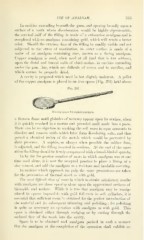Page 325 - My FlipBook
P. 325
USE OF AMALGAM. 323
In cavities extending beneath the gum, and opening broadly upon a
surface of a tooth where discoloration would be highly objectionable,
the cervical half of the filling is made of a submarine amaluam and is
completed with an amalgam containing gold, M'hich will retain a better
color. Should the external face of the filling be readily visible and not
subjected to the stress of mastication, its outer surface is made of a
wafer of an amalgam containing zinc, known as a facing amalgam.
Copper amalgam is used, when used at all (and that is but seldom),
upon the distal and buccal walls of third molars, in cavities extending
under the gum line, which are difficult of access and to sterilize, and
which cannot be properly dried.
A cavity is prepared which need be but slightly undercut. A pellet
of the copper amalgam is placed in an iron spoon (Fig. 292) held above
Fig. 292.
Heating spoon for copper amalgam.
a Bunsen flame until globules of mercury appear upon its surface, when
it is quickly crushed in a mortar and pounded until made into a paste.
There can be no objection to washing the soft mass in aqua ammonia to
dissolve and remove oxids which later form discoloring salts, and thus
permit a chemical union of the metals which would be prevented by
their presence. A napkin, or always when possible the rubber dam,
is adjusted, and the filling inserted in sections. At the end of the oper-
ation the filling should be firmly compressed with a broad-bladed spatula.
In by far the greater number of cases in which amalgam was at one
time used alone, it is now the accepted practice to place a lining of a
zinc cement, and add the amalgam as a resistant and insoluble covering.
In cavities which approach the pulp the same precautions are taken
for the prevention of thermal shock as with gold.
The most difficult class of cases in which to obtain satisfactory results
with amalgam are those opening alone upon the approximal surfaces of
bicuspids and molars. While it is true that amalgam may be manip-
ulated in .spaces impossible with gold foil even in soft cvlinders, it is
essential that sufficient room be obtained for the perfect introduction of
the material and its subse([uent trimming and })olishing ; for polishing
is quite as necessary an operation with amalgam as with gold. This
space is obtained either through wedging or by cutting through the
occlu.sal face of the tooth into the cavity.
Space is to be obtained and amalgam packed in such a manner
that the amalgam at the completion of the operation shall exhibit no


